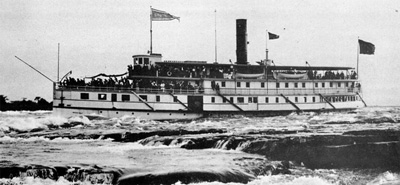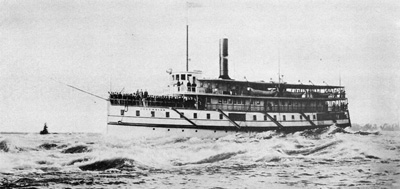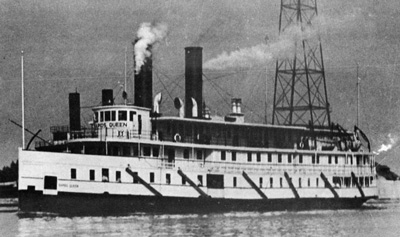Table of Contents
| Title Page | |
| Meetings | |
| The Editor's Notebook | |
| Marine News | |
| Vessel Passages | |
| Segwun - An Update | |
| Ship of the Month No. 77 Rapids Queen | |
| Proposal For A Slide Pool | |
| Additional Marine News | |
| Table of Illustrations |
In the Marine News section of our last issue, we mentioned that the cut-down remains of the once-famous passenger steamer RAPIDS QUEEN had finally returned to Toronto after an absence of forty-three years. Since it appears evident that this long-lived hull has taken up permanent residence in Toronto Harbour and will remain here as a breakwater for the foreseeable future, the time seems right to review the details of her career which has spanned the last eight-and-a-half decades.
It is with a certain amount of trepidation that we again mention the Richelieu and Ontario Navigation Company Ltd., for the name of this famous company seems to have crept into almost every issue of this newsletter. This is probably as it should be, however, for it is unlikely that any other vessel operator could be considered to have contributed as much as did the R & O to the economic development of the lower lakes and St. Lawrence River areas. Founded well before the Confederation of Canada and active until it was swallowed up by Canada Steamship Lines Ltd. in 1913, the R & O not only operated above and below the rapids of the St. Lawrence River but, indeed, right through them. The "Rapids Line", which connected at Prescott (and at Ogdensburg) with the Lake Ontario nightboats, took passengers down the rapids to Montreal, returning upbound through the old canals.
In 1892, the R & O took delivery of a new passenger steamer which had been built the same year at Chester, Pennsylvania, Hull 214 of the Delaware River Company. A steel-hulled, twin-screw vessel, she measured 175 feet in length, 34 feet in breadth, and 9 feet in depth, her original Gross Tonnage being registered as 884. The hull was sheathed in rock elm to protect her plating from the rigours of rapids-running. Her twin screws were driven by a triple-expansion engine with cylinders of 12 1/2, 19 and 30 inches diameter and a 15-inch stroke. Steam was provided by two coal-fired "gunboat" boilers which measured 8'1" by 19'6".
The new vessel was christened COLUMBIAN and was assigned official number U.S.126860. These two facts pose for us a bit of a problem. COLUMBIAN appeared on the St. Lawrence in 1892 and was operating for R & O at that time. The company acquired the ship for the rapids service and, as such, she would normally have operated between Prescott and Montreal, two decidedly Canadian ports. Why then was she placed in U.S. registry and given a name with strong American connotations? There would seem to be two possible answers, the first of which is that the R & O may actually have intended to operate the ship from Ogdensburg instead of Prescott. If this were the case, we still cannot see why she would be placed in U.S. registry, as she would not have stopped in U.S. waters between Ogdensburg and Montreal. In addition, R & O did not form an American operating subsidiary until about 1910.
The second possibility is that COLUMBIAN was not actually built for the R & O at all but rather was built on speculation by the shipyard in the hope that a buyer would be found for her on completion or while she was on the ways. Vessels were quite often built in this manner in bygone years, as it kept the shipyard crews busy during slack periods between orders. Needless to say, the practice died out as shipbuilding costs escalated in North American yards and as hulls became more specialized, the builders not wishing to be stuck with boats which could not be sold.
Whatever the answer, the R & O did take delivery of COLUMBIAN and brought her to the St. Lawrence River rapids route on which she ran along with the older steamer BOHEMIAN. COLUMBIAN had an enclosed main deck, with the usual exception of the open area around the dining room aft. The promenade deck was open for observation of the exciting rapids scenery and was equipped with a day cabin for those favouring protected seating arrangements. Some of the rapids boats, perhaps including COLUMBIAN, also provided limited stateroom accommodation, as the upbound trek through the old canals was often a long and tedious affair, for the canals were frequently jammed with traffic. The downbound run through the rapids was a matter of day travel only but passengers often had to remain aboard overnight whilst the ships were upbound. We say that COLUMBIAN was "perhaps" included, because early photos of her do not seem to show any stateroom accommodations.
COLUMBIAN carried her rather large pilothouse on the boat deck, forward of the officers' cabins and the shade deck. She was originally fitted with but one stack, set amidships, which was not visibly raked. Neither did her single mast display any rake whatever. In fact, COLUMBIAN was not a particularly stylish boat for her day; she looked rather stubby, too short for the size of her superstructure. While her hull did lift a bit at the bow, she had minimal sheer and her lines were not the sort to fill observers with ecstasy .
COLUMBIAN served Richelieu and Ontario well and in 1901 was sent to the shipyard at Sorel where she was rebuilt. At this time, her stack was moved considerably aft of its original location. Overnight accommodations were added and the 'midships section of the promenade deck cabin was extended outwards towards the sides of the ship. Photos would tend to suggest that she might have been lengthened in this rebuild, but the official record indicates no such alteration to the hull. By the time of this reconstruction, she had been brought into Canadian registry and enrolled as C.101254. She sailed under her original name until 1905 and then was renamed (b) BROCKVILLE in honour of the town located on the Canadian shore of the upper St. Lawrence River.
In 1909, BROCKVILLE was again taken to Sorel and this time underwent a major rebuild to bring her more in line with the needs of an increasingly-demanding travelling public. She was lengthened, and when she emerged from the yard, she measured 194.4 feet in length, her beam being 33.5 feet and her depth 8.8 feet. Her new tonnage was 1607 Gross, 770 Net. A large day cabin was added to the boat deck abaft the pilothouse and the boat deck was extended somewhat at its forward end. The most striking change in the steamer, however, was that she now sported two tall, heavy, and virtually perpendicular stacks. Set in tandem, they were very close together, the forward funnel being carried immediately behind the pilothouse. The promenade deck rail forward was closed in and adorned with magnificent golden trailboards featuring fierce-looking dragons.

The same ship, under the name BROCKVILLE, runs the same stretch of the Lachine Rapids sometime between 1901 and 1909. This Notman photo has not been retouched.
We might mention that it has been suggested that the lengthening of BROCKVILLE was carried out in 1912 at Kingston rather than in 1909 at Sorel. To date, we can find no support for this theory.
In any event, when BROCKVILLE re-entered service after her reconstruction, she did so under the name (c) RAPIDS QUEEN. This change was to accommodate a new naming scheme that R & O was developing for its rapids service. The older boats were being retired from service on this important line and the rebuilding of RAPIDS QUEEN was a major step in updating the company's facilities. The much larger RAPIDS KING (which was really too big for the route) had been built in 1907 and the most successful and best-known rapids boat of all, RAPIDS PRINCE, followed in 1910. These new steamers, together with their rebuilt older mate, could better take care of the passenger traffic delivered to Prescott by the Lake Ontario nightboats than could their predecessors.
RAPIDS QUEEN served the R & O faithfully in her new guise and, in 1913, when the company was absorbed into the newly-formed Canada Transportation Company Ltd. (soon renamed Canada Steamship Lines Ltd.), RAPIDS QUEEN went along with the rest of the fleet. C.S.L. made few changes in her operation and she ran basically as before, a major connection between Lake Ontario and the lower St. Lawrence steamers of the line. Many people will have fond memories of a trip through the rapids aboard RAPIDS QUEEN or RAPIDS PRINCE.
We have already mentioned that RAPIDS KING had been built for the Prescott-Montreal service in 1907. Unfortunately, R & O found to its chagrin that it had been a bit unwise when choosing a design for this boat. RAPIDS KING was just too big and deep for the route and spent much of her time, especially in later years when under the C.S.L. flag, laid up or assigned to other service, as she could only navigate the rapids when the water was high. As a result, RAPIDS QUEEN and RAPIDS PRINCE were the mainstays of the route. In 1929, RAPIDS KING was rebuilt at Lauzon, her upper deck being removed and other improvements made in the hope that she might do better on the rapids line. Even if this optimism proved to be unfounded (RAPIDS KING was laid up in 1931 and never turned a wheel until she was scrapped in 1949), C.S.L. took the opportunity to divest itself of the aging RAPIDS QUEEN.
The 38-year-old steamer was retired in 1929 and was sold to Sincennes McNaughton Tugs Ltd., Montreal. We do not know what she did for "Sin-Mac" in the intervening years, but in 1933 she was chartered out for service on Lake Superior between Fort William and Isle Royale. This route could hardly have been called a success, for she made but three trips and was then laid up at Fort William. As far as we can ascertain, she did not operate in 1934 but when navigation opened for the 1935 season, it seemed that RAPIDS QUEEN might have a promising career ahead of her.
Early in 1935, Messrs Crawford and Doty of Toronto formed a company known as Ontario and Quebec Lines Ltd., their intention being to run a passenger and freight service between Toronto and Montreal in opposition to Canada Steamship Lines. They cast about for a suitable boat and chartered RAPIDS QUEEN from Sincennes McNaughton for the season. Her hull painted green, her cabins white, and her stacks red with black tops, she arrived at Toronto on the afternoon of July 18, 1935 amid considerable fanfare; salutes were given to her by Sin-Mac equipment busily engaged near the Eastern Gap in attempting to right the overturned oil barge BRUCE HUDSON.
RAPIDS QUEEN was scheduled to leave Toronto each Monday at noon for a five-day return trip to Montreal. She was back in Toronto in time to run a weekend cruise to the Bay of Quinte and the Thousand Islands. Bookings were, at first, good and RAPIDS QUEEN seemed to be doing well, but after the novelty of the new service wore off, Ontario and Quebec Lines found that they were losing passengers back to the established C.S.L. operation, the travelling public being reluctant to forsake the opulence of the splendid KINGSTON and TORONTO. In a move to promote business, the new firm, although announcing publicly that it was loathe to take advantage of its permit to do so, began to serve beer and wine aboard the ship. It also cut ticket prices and, in due course, wound up battling C.S.L. in a fare war. It was patently obvious who the winner would be, and although RAPIDS QUEEN continued her sailings from Toronto's Terminal Warehouse through the summer season, the service was discontinued with the coming of autumn and RAPIDS QUEEN was laid up at Portsmouth. The charter was not renewed for the following year.
In 1936, RAPIDS QUEEN embarked on a project which certainly could be called unusual. She was chartered to Doctor Locke's Clinic and was taken to the town of Morrisburg, Ontario, on the St. Lawrence, where she served as a hotel for the clinic's patients. She served in this capacity all through 1936 and during 1937 as well, but by 1938, she was back at Kingston, laid up.
Late in 1938, RAPIDS QUEEN was sold to the Canadian Dredge and Dock Company Ltd., a major Canadian marine contractor. The old boat was moved to the C. D.D. yard at Kingston and there, on December 13, 1938, work began on the removal of her superstructure and machinery. Stripped to the main deck, she was converted to an oil bunkering barge and was given the unimpressive name (d) C.D. 110. Subsequent to the conversion, her Gross and Net tonnages were both registered as 412.
The work was completed by the following May and, on June 3, 1939. CD. 110 was taken in tow by one of the company's tugs. Her destination was Deschaillons, Quebec, on the south shore of the river between Trois-Rivieres and Quebec, from whence her bunkers service would be operated. She must have proven to be satisfactory in this trade, for she served in the same capacity at various locations until the completion of the St. Lawrence Seaway in 1959. C D&D was heavily involved in the Seaway construction and other major projects during the fifties, but when the new canal opened, it found itself the proud possessor of assorted steam tugs, dredges, barges, etc., for which it had no use. The bulk of this equipment was laid to rest at the company's yard beyond the LaSalle Causeway in Kingston Harbour. CD. 110 became a member of the boneyard fleet, having been towed back from the Seaway.
The people of Kingston, however, having some years previously succeeded in getting rid of the numerous sunken and rotting hulls abandoned in Portsmouth Harbour, did not take particularly kindly to the growing eyesore into which the C D&D premises were developing as the disused boats fell into grievous states of disrepair and unsightliness. Finally, during the 1970s, the company disposed of most of the old hulls for scrap, the "fleet" being decimated in fairly short order. CD. 110, however, had settled by the stern and was left where she lay, it being thought, apparently, that the cost of raising her was not warranted. She mouldered away at Kingston until 1978.
The Toronto area is well provided with facilities for yachtsmen, three of the major yacht clubs being located on the Toronto Islands. One, the Queen City Yacht Club, is established on the eastern end of Algonquin Island, immediately to the southwest and just across the lagoon from the Ward's Island ferry docks. In recent years, the Q.C.Y.C. has grown substantially in membership and additional mooring space has been made available in the lagoon. Access to the club from the west via the lagoon which swings in behind the island is restricted by a fixed bridge, and so most yachts must enter direct from the Bay between the clubhouse and the ferry docks. Unfortunately, the lagoon entrance silts up regularly and this leaves only a very narrow channel of navigable depth.
The Q.C.Y.C, for reasons of economics, decided to protect the channel with a breakwater, feeling that an old hull might be sunk in the relatively shallow water to the west of the channel to end the silting problems. The club shelled out the princely sum of $7,000 to Canadian Dredge and Dock in early 1978 and received in return the rusting, decrepit remains of CD. 110. The old hull was towed to Toronto on June 11 and was moored on the westerly side of the inner west pier of the Eastern Gap.
The Toronto Harbour Commission and the Metropolitan Toronto Parks Department, however, were not satisfied that, at some future date, the old hull might not rupture and permit the escape into the Bay of some noxious substance which could foul the island park's shoreline. Assurances were required that the hull be cleaned or some other arrangement made and, although we have no details, we understand that an agreement has been reached. Markers have been placed where CD. 110 will be laid to rest and her bulwarks have been painted royal blue to match the trim on the clubhouse. We understand that the placing of the hull will be made early next spring.
And so, RAPIDS QUEEN has come "home" at last for what will undoubtedly be a lengthy stay. Why do we call Toronto home for a boat which operated from this port for only one of her 86 years? We do so because for so long she provided the important connection with the Lake Ontario nightboats which permitted Toronto residents to travel comfortably by boat to and from Montreal and points east. We are pleased to have this historic hull so near at hand, but we would prefer to see her the way she looked back on that sunny afternoon in 1935 when she first sailed into Toronto Harbour.
Previous Next
Return to Home Port or Toronto Marine Historical Society's Scanner
Reproduced for the Web with the permission of the Toronto Marine Historical Society.

